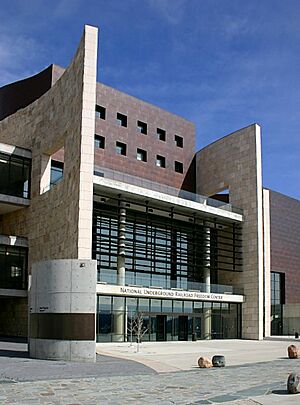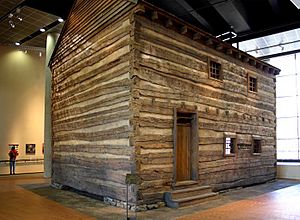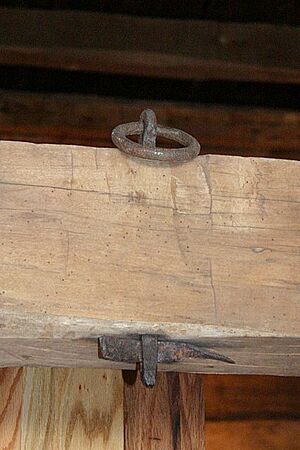National Underground Railroad Freedom Center facts for kids
 |
|
| Established | August 2004 |
|---|---|
| Location | 50 E. Freedom Way Cincinnati, Ohio 45202 |
| Type | Public |
| Visitors | 180,000 annual |
The National Underground Railroad Freedom Center is a special museum located in Cincinnati, Ohio. It teaches visitors about the Underground Railroad, a secret network that helped enslaved people escape to freedom. The museum opened in August 2004. It also honors everyone who worked to end slavery and gain freedom for all people.
This museum is one of several "museums of conscience" in the United States. These include places like the Museum of Tolerance and the United States Holocaust Memorial Museum. The Freedom Center helps people understand the fight for freedom in the past and today. It also encourages visitors to think about what freedom means in their own lives. Cincinnati was an important stop on the Underground Railroad. Thousands of enslaved people crossed the Ohio River from southern states to find freedom there. Many found safety in the city, and some continued north to Canada.
Contents
The Museum Building
It took ten years to plan, raise money, and build the Freedom Center. The building cost about $110 million. It officially opened on August 23, 2004. The museum is very large, covering about 158,000 square feet (15,000 m2).
Building Design and Features
The building was designed by Boora Architects and Blackburn Architects. It has three main sections that celebrate courage, cooperation, and perseverance. The outside walls are made of rough stone from Italy and copper panels. One of the architects, Walter Blackburn, said the building's wavy shape shows the fields and river that escaping enslaved people crossed. Important people like First Lady Laura Bush, Oprah Winfrey, and Muhammad Ali attended the groundbreaking ceremony in June 2002.
The Slave Pen Exhibit
The most important item at the museum is a large, two-story log slave pen. It was built in 1830 and is 21 by 30 feet (6 by 9 m) in size. By 2003, it was the only known slave jail still existing in a rural area. It was used to hold enslaved people before they were sent to auctions.
History of the Slave Pen
The slave pen was moved from a farm in Mason County, Kentucky. A tobacco barn had been built around it. It was carefully rebuilt on the second floor of the museum. Visitors can see it as they explore other exhibits. People walking outside can also see it through the museum's large windows.
The pen belonged to Captain John Anderson, a slave trader. Enslaved people from the area were held here for days or months. Traders waited for good market prices before sending them to slave markets in places like Natchez, Mississippi and New Orleans, Louisiana.
The pen has eight small windows, an original stone floor, and a fireplace. On the second floor, there are wrought iron rings. A chain ran through these rings to hold enslaved men on either side. Enslaved women were kept on the first floor and used the fireplace for cooking.
Carl Westmoreland, a curator at the museum, said, "The pen is powerful. It feels like a sacred place. When people stand inside, they speak in whispers." He believes it tells the story of the internal slave trade to future generations.
Visitors used to be able to walk through the pen. Now, it is closed off. The first names of some enslaved people believed to have been held there are listed on a wooden slab inside. These names were found in records kept by the slave traders.
Other Museum Features
The Freedom Center has many other interesting exhibits:
- The "Suite for Freedom" Theater: This theater shows three animated films. They talk about how fragile freedom can be throughout history. They especially focus on the Underground Railroad and slavery in the United States.
- The "ESCAPE! Freedom Seekers" Display: This is an interactive exhibit about the Underground Railroad. School groups and families can make choices about an imaginary escape attempt. This area shares information about important figures. These include William Lloyd Garrison, a leading abolitionist. It also features Harriet Tubman, an escaped enslaved person and "conductor" on the Underground Railroad. Another key figure is Frederick Douglass, an escaped enslaved person who became a powerful speaker against slavery.
- "Brothers of the Borderland" Film: This movie tells a story about the Underground Railroad in Ripley, Ohio. It shows how both Black conductors like John Parker and white conductors like Reverend John Rankin helped enslaved people escape.
- History of Slavery Exhibits: These exhibits cover the history of slavery and those who fought against it. This includes figures like John Brown and President Abraham Lincoln. It also covers the American Civil War that ended slavery.
- "The Struggle Continues" Exhibit: This exhibit shows the ongoing challenges faced by African Americans since slavery ended. It also highlights struggles for freedom around the world today. It explains how the Underground Railroad has inspired groups in places like India, Poland, and South Africa.
- The John Parker Library: This library has many materials about the Underground Railroad and freedom.
- The FamilySearch Center: Visitors can use this center to research their own family history.
- "Crossing to Freedom" Quilt: Artist Jane Burch Cochran created a large quilt called "Crossing to Freedom." It is 7 feet by 10 feet and shows symbols from the anti-slavery era to the Civil Rights Movement. It hangs at an entrance to the center.
See also




